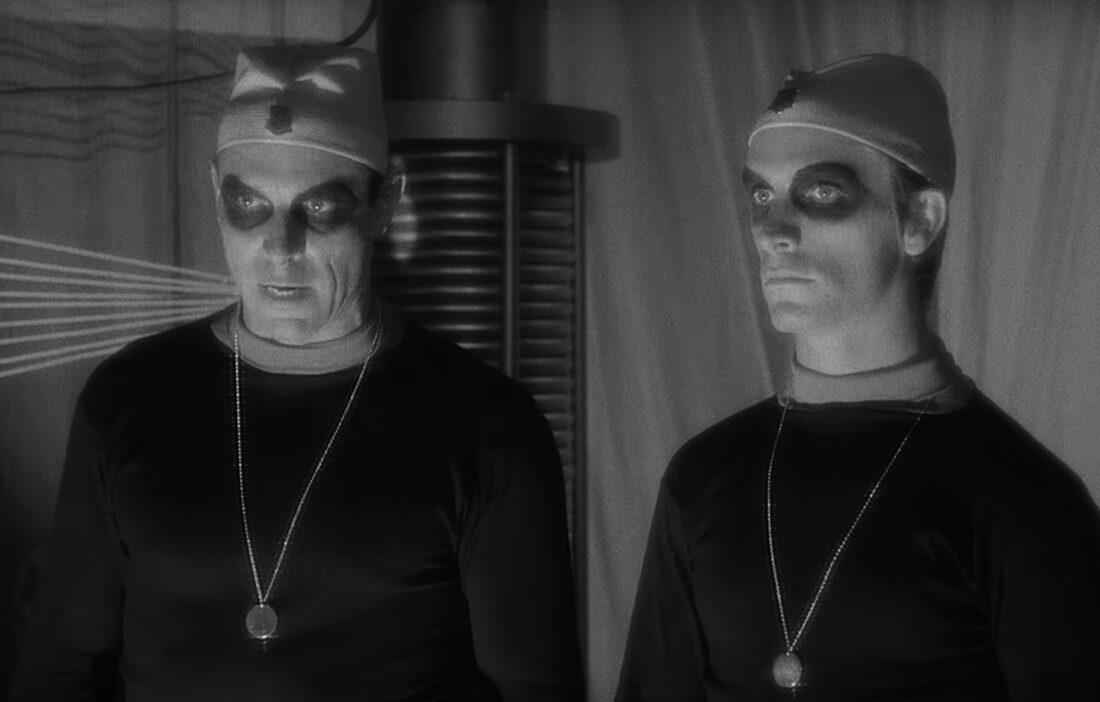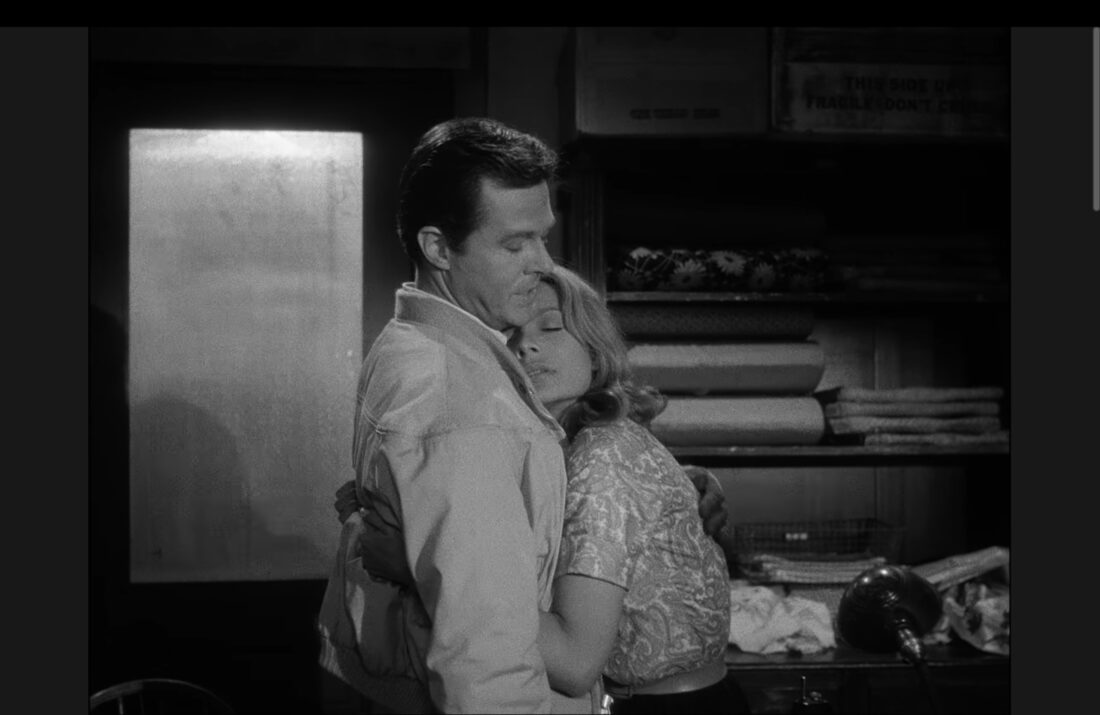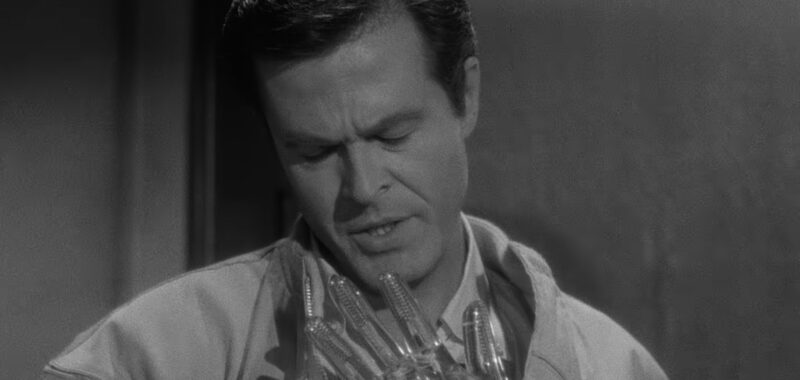It was 60 years ago (October 17, 1964, to be exact) that the ABC-TV sci-fi anthology series The Outer Limits premiered “Demon with a Glass Hand,” the fifth episode of the show’s second—and as it turned out, final—season. Directed by Byron Haskin (The War of the Worlds) from a teleplay by Harlan Ellison, “Demon” starred Robert Culp as Trent, a mysterious man with no memory who is tasked with preserving not just all human knowledge but the human race itself from a hostile alien race called the Kyben.
Trent is from 1,000 years in the future, when the Kyben brutally conquer Earth in 19 days, only for all of humanity to disappear overnight as a deadly radioactive plague renders the planet uninhabitable. Trent retreats into the past through a Kyben “time mirror,” with the aliens in hot pursuit and the answers to all his questions—where is the human race hidden? Why has he been chosen to protect them?—locked in the fingers of the computerized glass hand attached to his left arm. But three of those fingers are in the hands of the Kyben, and Trent must retrieve them to learn his purpose and humankind’s destiny.
Despite being produced during The Outer Limits’ checkered and shortened second season—after creator Leslie Stevens and showrunner Joseph Stefano had both departed the series—“Demon with a Glass Hand” is widely considered the finest episode of this often-groundbreaking anthology series. Winner of the 1965 Writers Guild Award for Outstanding Script for a Television Anthology, “Demon” is a tightly-constructed, expertly-paced, brilliantly shot hour of sci-fi television that stands tall among the many pioneering works of sci-fi cinema flourishing in the genre around the same time.
It’s a moody, stark, kinetic masterpiece with an often stunning, noirish visual palette (courtesy of Haskin and DP Kenneth Peach) and physicality that The Outer Limits was sometimes lacking, either thanks to crunched budgets or static direction. But in the case of this episode—which encompasses a cosmic storyline that spans 1,000 years and includes what’s implied to be a large-scale, devastating alien invasion of Earth—the show was able to corral its increasingly meager resources to create an atmospheric tale that captured the vastness of the story being told while staging it in surprisingly claustrophobic, intimate terms.
Ellison’s initial concept for “Demon with a Glass Hand” was meant to be large-scale in nature, like many of his short stories: he intended to have Trent chased across the country by the Kyben, who have adapted themselves to resemble humans. According to David J. Schow’s definitive book The Outer Limits Companion, Ellison described his original idea as his “homage to North by Northwest” before turning in a treatment that instead confined the action largely to one sprawling, unnamed city.

But even that version of the story—in which the main character (then called Mr. Fish) battles the Kyben through abandoned buildings, sewer tunnels, an amusement pier, and finally a length of railroad track outside the city limits—was too expensive to meet the budget demands imposed on The Outer Limits by the ABC network, which was already looking to cancel the show due to its relatively low ratings.
In his book (co-written with Herbert F. Solow) Inside Star Trek: The Real Story, Robert H. Justman—at the time assistant director on The Outer Limits—said he told Ellison that the show couldn’t be filmed as he envisioned it: “’We can’t afford to make this episode, Harlan,’” Justman recalled saying. “’The front office wants to junk the show, but I convinced them to hold off because I’ve got an idea about how you can salvage it.’” (Justman would face a similar scenario with Ellison three years later, when he was associate producer on Star Trek: The Original Series, over the budget for “The City on the Edge of Forever.”)
Justman’s idea involved a downtown Los Angeles landmark known as the Bradbury Building. The edifice was named after real estate magnate Lewis Bradbury (not Ray, sadly), who had it constructed in 1893. To this day, the building’s open, fifty-foot-tall court, baroque iron railings, marble floors, and open cage elevators are still a tourist destination, especially for fans of Ridley Scott’s 1982 classic Blade Runner, which used the Bradbury for its climax.
Justman convinced Ellison to retool his script so that the Kyben’s wide-ranging pursuit of Trent became vertical, contained to the one single building (called the Dixon in the script) surrounded by a Kyben-imposed “force bubble.” “It was a very important lesson to me,” Ellison acknowledged to David Schow. “You could make the action more intense by enclosing it, and providing no escape.”
More intriguingly, changing the contours of the chase also provided a metaphor for Trent’s own journey toward illumination: after a brief prologue in which he interrogates a Kyben before tearing off the medallion that holds him in the present—thus whisking him painfully and fatally back into the future—Trent slips into the basement of the building where the Kyben and their time mirror are based. Trent makes his way up through the building from there, killing Kyben as he goes, gradually collecting the missing fingers, gaining more knowledge, and even finding an ally—a poor garment worker named Consuelo Biros (Arlene Martel, later to play Spock’s intended wife, T’Pring, on the ST: TOS episode “Amok Time”) who happens to be working late when the Kyben seal off the building.
By the time Trent and Consuelo reach the top of the building—with Trent having destroyed the time mirror, killed all the Kyben, and retrieved all the fingers—his memories, as well as the memories of the hand, are complete. And the answers are not easy ones to hear: Trent is not a man but a robot, with all of humanity—70 billion souls—transcribed onto a single piece of wire embedded in his chest. His mission is to wait 1,200 years (1,000 until the Kyben invasion, then an additional 200 for the Kyben-annihilating plague to dissipate from the Earth) and unpack the entire human race again after the danger has passed. His vigil will be unimaginably long… and lonely.
It’s a poignant ending, made all the more forceful by the fact that this concentrated battle for the literal survival of the human species all takes place in this one dark, empty office building, fought by a robot, a woman, and a handful of alien beings, enclosed in a narrow labyrinth of staircases, offices, and storage areas. Trent’s journey up from darkness to light doesn’t bring him any relief or joy, as he faces an ocean of time all by himself—even the one person with whom he begins to make a connection, Consuelo, rejects him when she learns the truth of his existence.

The compact, vertical nature of the story’s twin pursuits—Trent’s hunt for the answers and the Kyben’s pursuit of him—is also mirrored by the incredibly small composition of the ultimate prize. All of humanity is broken down to electrical components and stored on a single piece of wire; it may sound implausible even now, but think of how much you store on a typical iPhone—or more specifically, the tiny components inside the device that provide that storage. Is it that far-fetched to imagine storing an entire population in the same way?
Of course, even as (for the early 1960s) a forward-thinking network TV production, “Demon with a Glass Hand” is not without its faults. Although it’s established that the Kyben have changed their form to resemble humans, their black-ringed eyes, skullcaps, and black bodysuits don’t do much to reflect the threat they pose to the human race. In a few shots, the lighting makes them resemble reanimated corpses—an idea that might have been interesting to run with. In addition, for such advanced beings, they carry standard guns and shout to each other across the Dixon’s central court, not the best way to communicate when you’re trying to capture a fugitive hidden in the building. The medallions around their necks, fully visible, are also easy to yank off, making the Kyben relatively effortless to dispatch.
But the show’s biggest problem is Consuelo. Ellison’s original conception of a Black woman was nixed by the network, so he made her Latina instead. Even that was watered down by the programming heads, with her last name of “Losada” swapped out for the more ethnically vague “Biros.” Martel’s portrayal of her is sensitive and compassionate—a spiritual woman repulsed by violence because of the violence done to her by her late husband—but she doesn’t escape the standard trope of being there to merely support Trent and, as was often the case on network TV, fall in love with him within hours of meeting him. Even her empathetic nature is somewhat undercut by the ending, when the shocked Consuelo ditches the heartbroken Trent like an overheating mobile phone when she learns he’s an android.
Those issues aside, “Demon with a Glass Hand” remains a masterclass in telling a large-scale story in very intimate fashion. Ellison’s take on the “Eternal Man” has mythic connotations that have long fascinated many writers, including Ellison himself, who set several other stories in the universe of the Earth-Kyba war and hinted for many years that he planned to write a direct sequel to the original episode. In 2014, it was even announced that director Scott Derrickson (Doctor Strange, The Black Phone) was going to adapt “Demon” as an Outer Limits feature film, which never came to fruition.
Perhaps it’s just as well: “Demon with a Glass Hand” works so well because of its low-fi, self-contained nature, and because its mythic struggle takes place in a space less than the size of a city block. Its metaphor for the passage from unawareness to knowledge remains apt, and Trent’s realization that his ultimate purpose will leave him in a friendless, joyless, twilight half-existence for more than a millennium is one of the more haunting endings you’ll ever see on vintage network TV. Climbing upward from the dark into the light of knowledge can often come with a terrible price.

